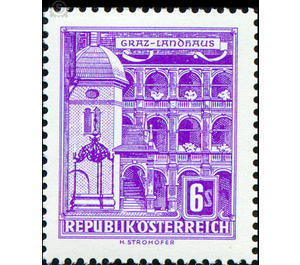Structures - Austria / II. Republic of Austria 1960 - 6 Shilling
Theme: Architecture
| Country | Austria / II. Republic of Austria |
| Issue Date | 1960 |
| Face Value | 6.00 |
| Color | violet |
| Printing Type | offset |
| Stamp Type | Definitive |
| Item Type | Stamp |
| Chronological Issue Number | 397 |
| Chronological Chapter | OOS-OE2 |
| SID | 367039 |
| In 109 Wishlists | |
Graz, the green capital of Styria, was already a very popular settlement area due to its ideal geographical location between Mur and Schloßberg. The city was first mentioned in documents in 1115. From the built on the Schlossberg weir (Gradec = small castle) Graz also has its city name. In the year 1180 Styria became duchy, which fell 12 years later under the Babenbergern and 1283 under the Habsburgs at Austria. As a borderland against the East, Styria primarily fulfilled an important protective function and for many centuries was influenced by the most varied artistic currents. These are reflected in the extensive number of architectural and artistic features of this city. The brand motif shows a special jewel of historical architecture of the city, the Grazer Landhaus. From small beginnings, this House of Estates has become in more than four centuries the first and noblest secular building of the whole country. Since 1494 the chancery and meeting place of the state estates, it arose from several town houses and grew from the 16th to the 19th century to a large building complex with several arcade courtyards. In Schmiedgasse you can see the oldest part with the majestic simple round arch gate from the year 1553, which was to have been erected by the stonemason Hanns Schweigauer from Steyr. At the corner of Landhausgasse and Schmiedgasse, the knights' wing built in the years 1527 to 1531 by Italian builders rises.


